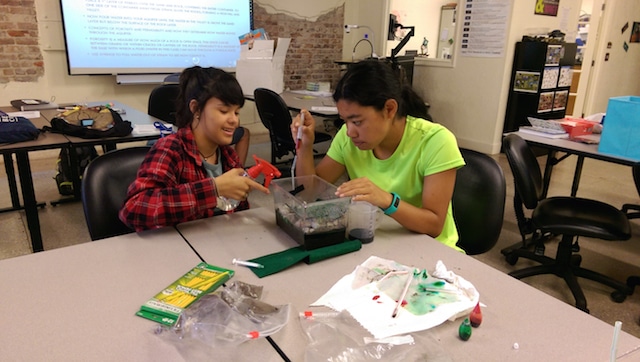
Tourism may be the heartbeat of Florida, but clean freshwater is the state’s lifeblood.
When millions of thirsty Central Floridians and visitors around the Sunshine State crave an antidote for the sizzling summer sun, they often turn to a tall, cool glass of aqua from down under.
Not Australia, but rather aquifers. These are “vast underground, porous rocks that hold water and allow water to move through the holes within the rock,” according to the St. Johns Water Management District.
Not every Floridian understands the geological aspects of the subterranean thirst quenchers. Most understand the basics of Florida’s water reality — aquifers supply 90 percent of water for Floridians.
Four Summer for Success students now understand that reality better after a hands-on lesson Tuesday in aquifer composition in the Everyday Florida Science class, part of the college’s three-week immersion program for high school students who learn differently.
The quartet — Laurabelen Gutierrez, Rylie Tong, Rose Watkins and Zoya Sanford — created models of the Floridan aquifer, the largest aquifer in the southeastern United States.
The Floridan aquifer averages 1,000 feet in thickness, stretches beneath the entire state and portions of Alabama, Georgia and South Carolina, and extends into the Gulf of Mexico and the Atlantic Ocean. Freshwater can range up to 2,000 feet below the surface.
In the science lab, students watched a PowerPoint presentation on aquifers then engaged in a group discussion before launching into creator mode.
Laurie Staiger, a learning specialist and academic advisor at Beacon College — the first higher-education institution accredited to award bachelor’s degrees primarily to students with learning disabilities, ADHD and other learning differences — led students through a process “representing the layers beneath our feet in Florida, from the limestone deep below to the grass on top.”
Rainfall replenishes, or recharges the aquifer. While Florida averages 51 inches of rain annually, only about 13 inches reaches the aquifer.
In creating their models, students, added the water, simulated rain and tossed in pollutants for good measure, to explore how toxins leech into the water system.
It proved a revealing exercise in unexpected ways.
“It was wonderful that the next generation showed such a deep caring for the environment,” Staiger said, “and enjoyed the hands on experience of playing in the dirt to create and better understand an aquifer.”